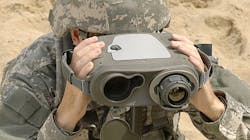Army, Northrop Grumman, BAE move forward on next-generation JETS infantry targeting system
ABERDEEN PROVING GROUND, Md., 20 June 2012. Systems designers at two U.S. military electro-optics powerhouses are ready to square off on the next phase of a program to develop the U.S. military's next-generation target-location and fire-support system.
The BAE Systems Electronic Systems segment in Nashua, N.H., and the Northrop Grumman Corp. Electronic Systems segment in Apopka, Fla., are getting ready to start full-scale development of the Joint Effects Targeting System (JETS) Target Location and Designation System (TLDS).
The U.S. Army Contracting Command at Aberdeen Proving Ground, Md., announced plans to issue a formal request for proposals (RFP W91CRB-12-R-0045) as early as 29 June for engineering and manufacturing development (EMD) of the JETS TLDS. BAE Systems and Northrop Grumman have worked to develop early JETS technology.
The Army established the JETS program in 2009 as an Army, U.S. Air Force, and U.S. Marine Corps initiative to develop and field a one-man portable targeting system to enable infantry forward observers and tactical air controllers to call for fire from indirect munitions like JDAM and Excaliber, as well as call for close air support from all joint forces.
Among the goals of JETS is reducing friendly fire and collateral damage by helping soldiers differentiate between enemies, friendly forces, and civilians while working with satellite positioning and surveillance data.
Military forces need a lightweight handheld system for reconnaissance, surveillance, target acquisition, target engagement, and fires coordination for infantry forces, Army officials explain.
Current systems are far too heavy or lack necessary capability for accurate fire support during the day and at night, and do not work well with digital communications necessary to receive, transmit, store, display, plan, and coordinate targeting data.
This solicitation will call for industry to design and build JETS prototypes as part of the program's full-scale development phase, which should last for about 2 1/2 years, during which the winning contractor will be asked to deliver between five and 20 prototype JETS systems.
Story continues below videoJETS has two major subcomponents: the Target Location Designation System (TLDS) and the Target Effects Coordination System (TECS). The TLDS helps infantrymen acquire targets quickly.
The TECS, meanwhile, sends targeting data to digital fire-control networks that direct artillery, missiles, and aircraft attacks. The JETS user first will identify his location and target, and then sends that data to battle command systems for calls for fire.
BAE Systems engineers are expected to build on their company's Laser Target Locator Module (LTLM) technology that BAE Systems officials say will enable infantrymen recognize targets more than 2.6 miles away in daylight, and about half a mile away in total darkness.
Northrop Grumman systems designers, meanwhile, will draw from technology they developed building the company's Mark VIIE Hand-Held Target Locator that can identify enemy positions and locations during the day or at night using electro-optics, laser rangefinder, and embedded GPS.
The Army's point of contact for the upcoming JETS TLDS solicitation is Peter Buckless, who can be reached by phone at 410-306-1887. More information is online at https://www.fbo.gov/notices/015ff2f17e321e1f2ac911babfaab9a6.
Follow Military & Aerospace Electronics and Avionics Intelligence news updates on Twitter

